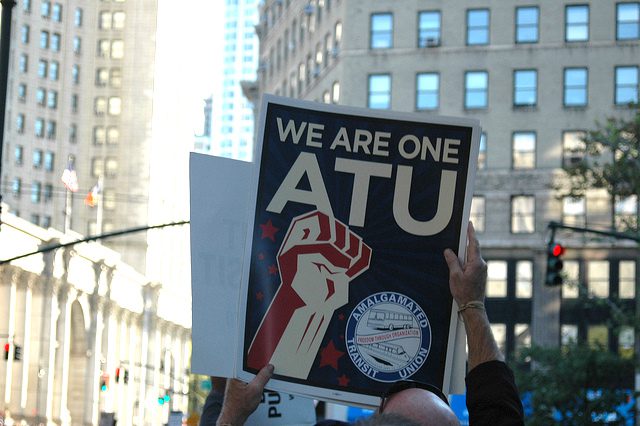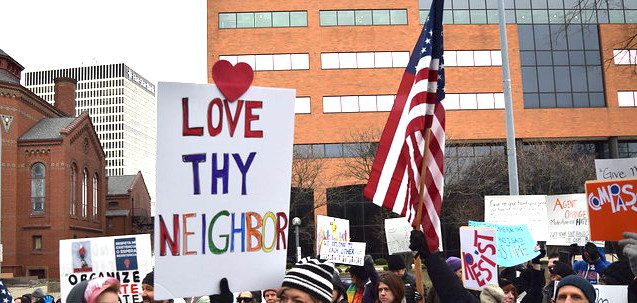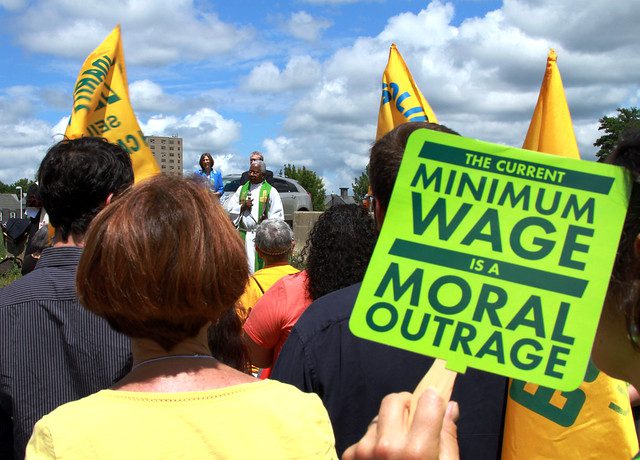
Photo from the Union rally and march to support Occupy Wall Street, 2011. Photo by Eric Goldhagen via flickr, CC BY-NC-SA 2.0
The response to counter-demonstrators at a white supremacist rally by the Portland Police Department (PPD) is being criticized in advance of more such gatherings nationwide. One of the most notable critics, the American Civil Liberties Union’s Oregon branch, said that the PPD’s military-like tactics—which protesters said used stun grenades and rubber bullets—are a violation of rights and should be banned from use against protesters. Individuals on social media expressed outrage that those tactics seemed to be used disproportionately against people speaking out against attendees of the Patriot Prayer rally.
The D.C. transit union exercised its own right to act against hate a few days ago when it issued a statement declaring that it would not be providing separate transport of alt-right/white nationalist groups to a rally scheduled for this weekend. The announcement from Amalgamated Transit Union Local 689 came after the DC Metro transit system had floated the idea of separate train transport in an effort, they said, to dampen tensions between the hate groups and counter protesters. The idea sparked immediate backlash from ATU 689, a majority Black union of transit workers, which said in its statement, “Local 689 is proud to provide transit to everyone for the many events we have in D.C. including the March [for] Life, the Women’s March, and Black Lives Matter. We draw the line at giving special accommodation to hate groups and hate speech.” Yes to union power.
And in another win for labor, Missouri voters said no to Proposition A, a ballot referendum for a Right to Work bill that had passed last year by the (then) governor. This was the first time since 2011 (in Ohio) that voters have overturned such a law with a ballot referendum. Cheers to Missouri, and cheers to union power. #OrganizingWorks.
The administration has proposed a sweeping overhaul of the financial and mortgage system. There will, we’re sure, be a lot more to say about this in the weeks to come. There are probably some good things embedded in there, but it’s hard not to be heartily suspicious in the current climate of “regulatory sandboxes,” wherein regulators would work directly with the companies they regulate to help firms innovate new products and services without fear of a regulatory smackdown. What could go wrong? Meanwhile the OCC is going to offer bank charters to fintech companies. Here’s some context for that decision.
“Food establishments are often messengers of gentrification” is part of the description of a public art exhibition in Nashville called Build Better Tables that aims to examine inequality in urban development through the lens of food and the food service industry. One of the participating artists’ projects, H*t Chicken Sh**t, presents difficult conversations about race and gentrification along with dinner. The evening also features an uneven distribution of food to diners seated at different tables, and a solicitation of diners to pledge either funds or land they own to a land trust the artist/organizer is working to form.
The Chicago Rehab Network (CRN), an association of community development organizations, has released its latest five-year plan for affordable housing in the city. The plan is a comprehensive yet succinct look at what’s needed, from rental to affordable ownership to land-use regulation, and CRN uses it as a basis for its advocacy work. We’re thinking it would be pretty great to have one of these nationally.
Despite a determined show of resistance from community residents and housing activists, the New York City Council approved a rezoning of 59 blocks in the upper Manhattan neighborhood of Inwood this week. Days prior to the final vote, a group of nearly a dozen people camped overnight in the office of Ydanis Rodriguez, the city council member who represents the neighborhood, to bring more attention to the issue. North Manhattan is Not For Sale, one of the groups pushing against the plan they believe will speed-up unaffordability and displacement of lower-income residents, vows to continue its protests. Said one member, “I feel heartbroken that developers’ interest always seems to trump the interest of the community. And I think what gives me comfort and inspiration is seeing how hard this community fought back.”
The Seattle Children’s Hospital Clinic is intended to serve low-income and marginalized populations—which in rapidly gentrifying Seattle has meant that the clinic itself has had to open a new location to remain accessible to the community it serves, who are being displaced southward. The clinic, which recognizes the connections between housing, poverty, and health, specifically chose a new neighborhood that was trying to put measures in place to prevent further displacement. Its new location is at a light rail station as well, hopefully making it within reach for making who need it. Here’s hoping access to the clinic will be part of a package making life in South Seattle stable and healthy for the region’s economic refugees.
Growing Pains. We wrote in the spring about Aeon, a nonprofit developer in the Twin Cities region, making a large market purchase of unsubsidized affordable housing in a bid to keep it affordable. Unfortunately, the challenge didn’t end with closing the purchase; tenants and the city are frustrated with the slow pace of repairs and solving of problems. Aeon has acknowledged things are moving too slow and is staffing up to try to address the problems. We hope once they get caught up that they share lessons with other groups looking to make similar purchases about what they’ve learned about due diligence and capacity needs.
Well this is scary—If you send your kid to college, you could risk losing your home. A troubling study in Democracy shows that college attendance played a role in the high number of foreclosures during the Great Recession. “Nationwide, they found a 1 percent increase in college attendance could be expected to lead to between 11,200 and 27,400 additional foreclosures,” according to a report in the Washington Post. The study’s authors don’t believe forgoing a college degree is the answer, despite the ever-increasing cost of a post-secondary education.
Oh Wells Fargo. We learned this week that hundreds of Wells Fargo customers lost their homes when the bank accidentally foreclosed on the properties due to … wait for it … a computer glitch. The news came out less than a week after the bank agreed to pay a $2 million fine for issuing loans it knew were based on false information. We have a sneaking suspicion that these types of issues will continue to pop up.
A homeless person who sleeps outdoors is three times more likely to die than a homeless person who lives in a shelter, according to a Massachusetts-based study. And adults who sleep outside are 10 times more likely to pass away than the overall Massachusetts population. The most common causes of death were heart disease and cancer. We know we need to find better ways to shelter homeless adults, because after all, homelessness is a housing problem. This study highlights its hazard to health, as well.
Before New York City became the first major city in the U.S. to hit the breaks on new licenses for ride-sharing services like Uber and Lyft, rallies were held in support of and against the action. What was most interesting to us were the social justice leaders who were not in favor of the change. They recalled stories of not being able to hail a taxi because of the color of their skin. “So I had to call a Lyft,” Symone Sanders, a political strategist and former Bernie Sanders campaign aide, told the Daily News. “The sad part is, my story is not unique. This happens to countless Black and brown folks all over the city of New York.” Sanders is right, it’s not uncommon—search “Hailing While Black” and you’ll find story after story of people who have faced discrimination trying to hail a taxi.
This interactive Voter Precinct Map from The New York Times is endlessly fascinating, if only for the wonderment (who were the 20 people in my precinct who voted for Trump?!). But it’s also fascinating, if predictable, how much it reflects racial residential patterns. Take a look at all those blue precincts in the Deep South…





Comments